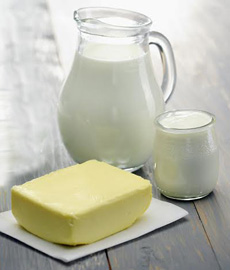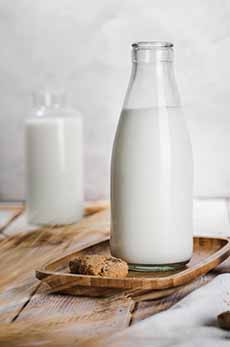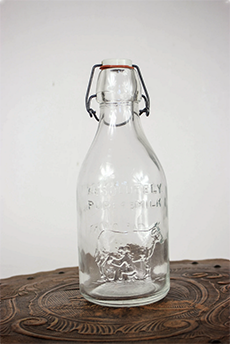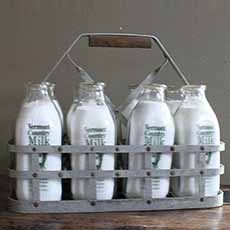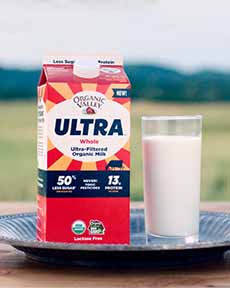Milk Carton History To Celebrate National Dairy Month
|
June is National Dairy Month, so how about some fun facts? Let’s start with milk delivery. In the late 1700s, every American household had a cow. A prosperous family might have two. As industrialization moved people into more urban areas, there wasn’t anywhere to keep a family cow. That’s when people began to buy milk from local dairy farmers instead. The history of the milk carton (photo #8) follows. > There’s fun milk trivia below. The first home milk deliveries in the U.S. occurred in Vermont in 1785. The milkman in a horse-drawn wagon would go door to door with a metal barrel full of milk. People would come out with their containers to get milk, or leave whatever containers they had—jugs, pails, or jars—on their front steps, and the milkman would fill them. Daily deliveries were required, because, in the days before refrigeration, the milk wouldn’t keep until the next day (cold winter days excepted). While it was possible for visitors to dairies to purchase fresh milk packaged in jars*, this was in limited volume and not “commercial distribution.” The first milk bottle in the U.S. is credited to Harvey D. Thatcher, a New York druggist who introduced his milk bottle in 1884. The story is that Thatcher was disgusted after watching a milkman dip from a milk can into which a child’s toy had dropped, and was motivated to create a solution. There were numerous patented milk jars prior to Thatcher’s, but his was the first to include a cap [source]. Early Thatcher “milk protector” bottles used a now-familiar ball-type closure (also called a swing stopper) affixed by wires (photo #5). His bottle was embossed with a Quaker farmer milking a cow. Great idea, the swing stopper; but alas, Thatcher failed to patent his invention. (The same type of bottle is used today for other beverages, including beer). But his legacy was that for which many collectors of old milk bottles are thankful. Soon, more dairies began to create their own proprietary designs. By the 1920s both designs and advertisements were etched onto the bottles. The first glass milk bottle granted a patent was the Lester Milk Jar (photo #4), designed by George Henry Lester and patented on January 29, 1878. More complicated than the Thatcher, the glass bottle had a glass lid that was held in place with a metal clamp-pressure screw device. It went into commercial use the following year. In today’s environment of throw-it-away, it’s nice to remember that in the old days, the empty bottles were picked up, returned to the farm or plant, and washed for re-use. The glass bottles made it easier for milkmen to make their deliveries, and for the dairy farms to keep track of how much to charge customers. Customers left standing orders, and milkmen carried the milk and cream in metal baskets (photo #6), placing them into insulated galvanized steel boxes (photo #7) on the front or back porch, without disturbing the household during the early morning delivery. Some homes had insulated cubbies built into the side of the house. Families woke up to fresh milk. While glass milk bottles were almost unanimously clear, for a while, some amber-colored milk bottles were produced, in response to the now-disproved belief that dark glass would keep milk from spoiling when exposed to light (in fact, heat, not light, is the culprit). There were also rare occasions when white milk glass and green glass bottles were used [source]. Waxed cardboard containers for milk started to appear as early as the 1890s, but before the homogenization† of milk in the 1920s and the sale of separate pints of cream, customers couldn’t see the milk inside, to see how much cream they were getting (the cream layer rose to the top). In 1915 John Van Wormer, a toy manufacturer in Toledo, Ohio, was granted the first patent for a “paper bottle,” which was the first folded blank box for holding milk. He called it the “Pure-Pak.” He was motivated to create a cardboard carton after dropping a glass bottle of milk. He created the machinery to make the cartons, which were delivered to dairies in flattened form. The dairy then folded, filled, and sealed the cartons. Because the cartons could be thrown away instead of reused, Wormer’s called his product the “Pure-Pak.” In 1928, Sheffield Farms in New York began using waxed cardboard cartons for their milk deliveries, but the glass milk bottle continued to be the main container of retail distribution for many decades. By the 1940s, waxed cardboard containers with peak rooftops became common (today plastic is substituted). This design, though, had actually been around since 1915 [source]. Even though most homes had refrigerators, some families preferred to continue having their milk delivered by the milkman. (Surprisingly, home delivery of milk is having a renaissance, as some families want fresh milk produced locally, instead of a conglomerate of interstate dairies who send their milk to a distribution plant to be blending with other dairies’ milks. If you’re interested, you can find a home delivery dairy here.) In the mid-1960s, single-use plastic milk jugs were introduced. The end of the 1960s also saw the demise of the milkman, as suburban sprawl made delivery routes longer and less financially feasible, while supermarkets made it convenient for consumers to get their own milk. In 1989, Peapod became one of the early online grocery delivery services. Today’s market leader, Fresh Direct, began in 2002. Amazon Fresh arrived in 2007. And this, dear reader, is known as a paradigm shift. *There is information on the Internet that on April 8th, 1879, Echo Farms Dairy of Litchfield, Connecticut was the first to home-deliver bottled milk. However, despite research by the Connecticut Historical Board, no hard information has been found to substantiate this claim. However, an 1879 ad from the dairy does mention that the milk was sold in cans [source]. †Homogenization does not affect the composition of the milk. It only changes the size of the fat globules, making them more uniform. Thus, the fat will remain more evenly dispersed throughout the milk and will not rise to the top or cling to the sides of the container. |
|
|
|
|
||
